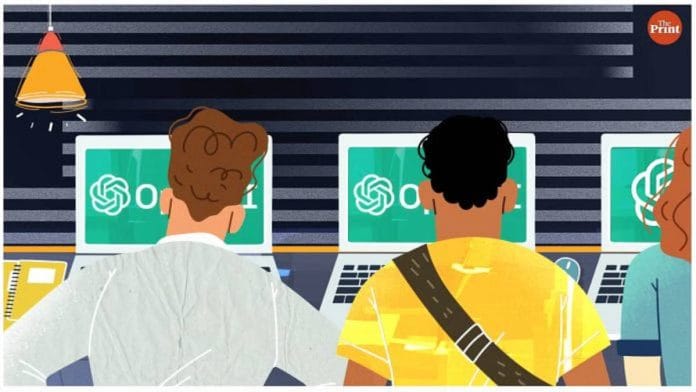Delhi: India is emerging as the biggest consumer of news using AI chatbots like ChatGPT and Google Gemini, globally. According to Digital News Report 2025, “Almost a fifth (18 percent) of our Indian sample said they were using chatbots such as ChatGPT and Google Gemini to access news weekly, with comfort levels of 44 percent”.
In contrast, countries like the UK (11 percent), Belgium (10 percent), Finland (10 percent) are relatively less comfortable using AI. The usability of AI-generated news in the UK is as low as 3 percent.
The Reuters Institute Digital News Report 2025—released on 17 June—is based on an online survey of 2,044 Indians with options to complete the survey in both Hindi and English. In total, 48 countries were covered in the survey including India.
YouTube remains at the forefront of online news consumption in India with 55 percent respondents using the platform to access news. Next is WhatsApp with 46 percent, although it declined by 2 percent from the previous year.
Whereas, among global respondents, Facebook at 36 percent remains the top source to access online news behind YouTube (30 percent) and WhatsApp (19 percent).
The preference of news consumption is shifting. Around 38 percent Indian respondents say they prefer to read news, which is less than the global average of 55 percent; and 40 percent of Indian respondents prefer to watch news, in comparison to 31 percent in average globally.
While in countries like the US, UK, Germany and Norway, the majority (over 50 percent) prefer to read news.
In terms of trust in news, 43 percent respondents in India have faith in news, highest in the last five years, while it was 40 percent on an average across 48 markets, unchanged from the last 3 years.
In context to India, the report states, “When it comes to brand trust, legacy print titles and public broadcasters tend to enjoy higher levels of trust. However, brands that are either extremely critical or extremely uncritical of those in positions of power, tend to have lower trust scores in a polarised environment.”
Indians are ‘outliers’ in news consumption
While global audiences remain broadly sceptical of AI-generated news, Indians appear to be the most comfortable with it—44 percent express ease with such content, and 18 percent already use chatbots to access news.
“Several Indian newspapers have launched YouTube channels using high levels of automation and AI presentation,” states the report.
However, the report also highlights that this phenomenon is prevalent in Asia where scepticism regarding AI generated news is less when compared to North America and Europe.
In terms of news consumption, 76 percent Indian respondents have strong preference for smartphones to get news, with social media platforms like YouTube, WhatsApp, Instagram and Facebook being the most famous among English speaking respondents.
With 55 percent respondents in India using YouTube for news consumption is highest globally. The primary reason given in this regard in the report is relatively cheap data charges and low levels of literacy levels.
Despite WhatsApp being the second most popular option of online news consumption in India, it is also the biggest source of misleading information.
The report states, “Meta owned WhatsApp was cited by more than half of our Indian survey respondents (53 percent) as the channel that carried the biggest threat when it comes to false and misleading information, by far the highest score across markets.”
The report pegs India’s internet penetration at 56 percent.
Global scenario on subscription model, social media and AI
The report highlights that even as publishers seek to diversify revenue streams, digital subscription models remain stagnant. Among respondents in the 20 wealthiest countries surveyed, only 18 percent pay for online news, with the majority still opting for free news offerings.
Norway, at 42 percent of the respondents, has the highest proportion of paid subscribers, while a large nation like the US is at 20 percent.
Similar to India, preference for video as a source of news continues to rise globally. “Across all markets the proportion consuming social video news has grown from 52 percent in 2020 to 65 percent in 2025,” states the report.
Social media platforms are dominating the consumption patterns across all markets. Six online platforms—Facebook, YouTube, Instagram, WhatsApp, TikTok and X—now hold more than 10 percent weekly news content. It was 2 percent a decade ago.
“Around a third of our global sample use Facebook (36 percent) and YouTube (30 percent) for news each week. Instagram (19 percent) and WhatsApp (19 percent) are used by around a fifth, while TikTok (16 percent) remains ahead of X at 12 percent,” the report states on the use of social media platforms for news.
Globally, AI-generated news is still a relatively new phenomenon, but a growing one. The integration of AI chatbots into search engines to deliver real-time news is likely to accelerate this growth.
While only 7 percent respondents allude to using it, the share rises to 15 percent among those under the age of 25.
“Audiences in most countries remain sceptical about the use of AI in the news and are more comfortable with use cases where humans remain in the loop.”
The report added, “Across countries, they expect that AI will make the news cheaper to make (+29 net difference, i.e. more respondents agree than disagree), and more up-to-date (+16).” However, they also believe it will make the news less transparent (–8), less accurate (–8), and less trustworthy (–18).
(Edited by Zinnia Ray Chaudhuri)
Also read: ‘If ChatGPT is Jab We Met’s Aditya Kashyap, Grok is Kabir Singh’. Elon’s chatbot sets off meme fest






